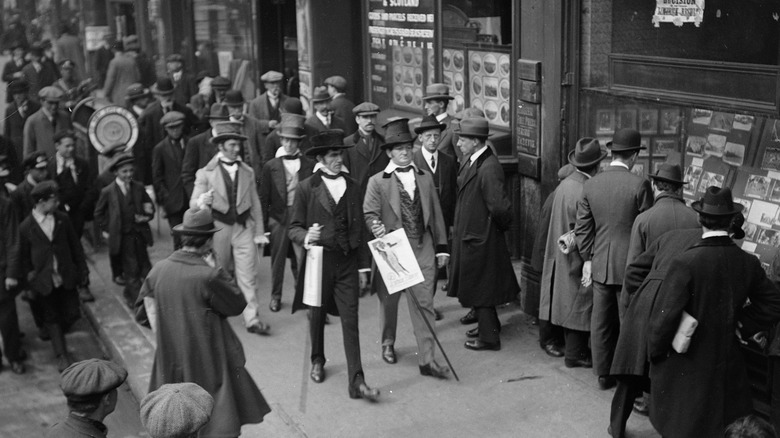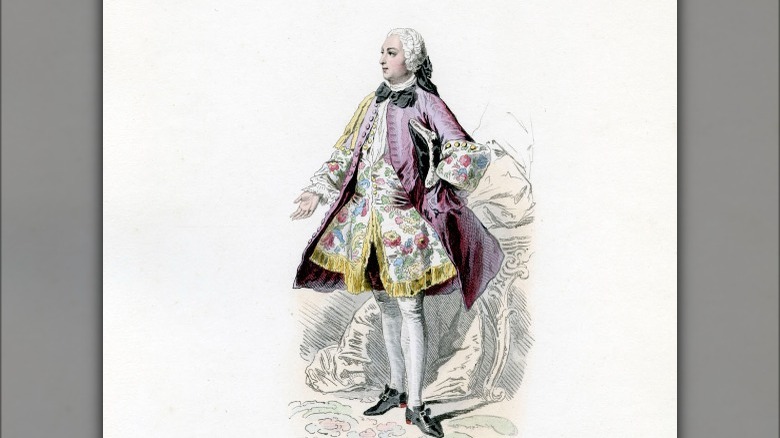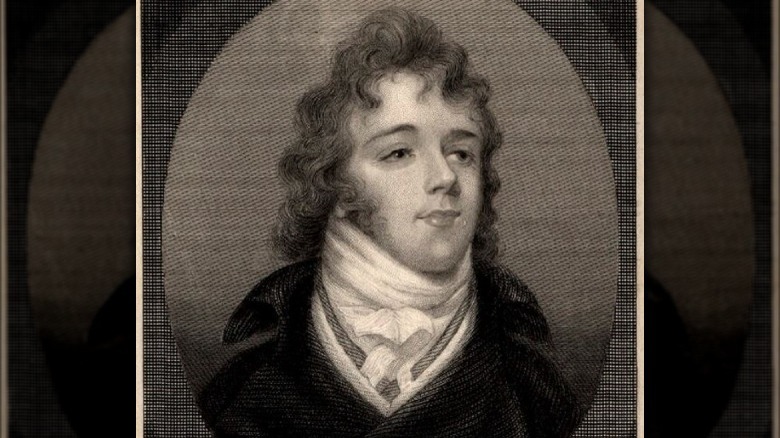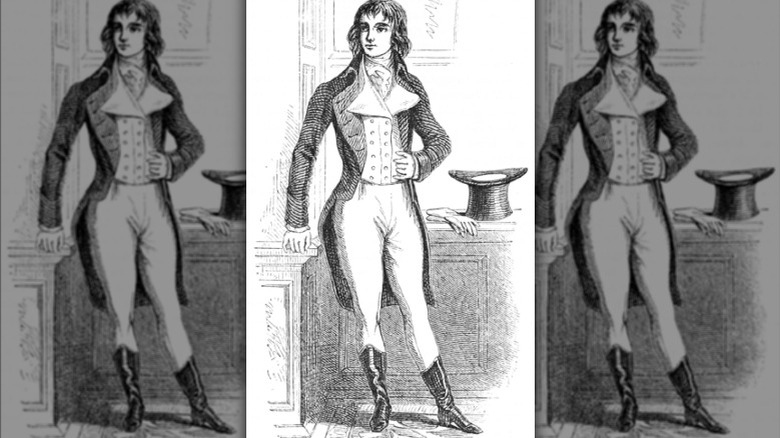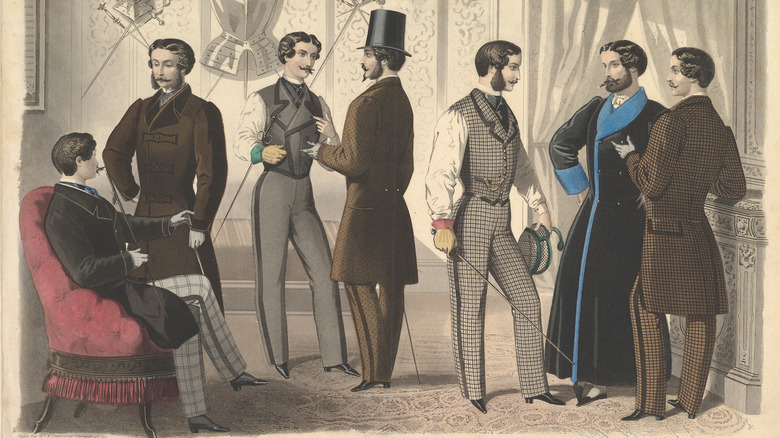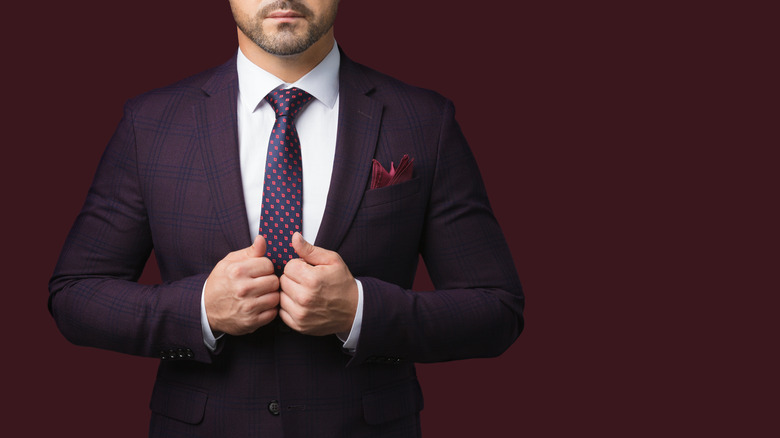What Was The Great Male Renunciation Of The 18th Century?
Men's fashion today is different from what was deemed fashionable centuries ago. In the past, men typically wore voluminous clothing with extravagant detailing, such as seen in centuries-old portraits. Clothing consisted of linen shirts, a jacket, skirts, and an overgown (via Hisour). They wore breeches, doublets, cloaks, and capes embroidered with decorative pieces, lace, jewels, and other embellishments. Common fabric colors were green, red, yellow, and purple, which made attires more vibrant. Apart from the said pieces, men also wore elaborate wigs, white powder and rogue on their faces, and perfume to complete their looks.
By the end of the 18th century, however, men's fashion drastically changed. Gone were the big silhouettes, wigs, and colorful garbs, and they were replaced by long trousers, boots, fitted coats, and fabrics with muted colors, according to the Gentleman's Gazette. The fashion revolution was called the Great Male Renunciation, and the movement made men abandon their love for elaborate clothing in exchange for practicality.
The idea behind the Great Male Renunciation
Before the Great Male Renunciation, fashion was one of the ways men boasted their status and wealth, thus the voluminous and luxurious — yet impractical — clothing choices, per BBC. After the French Revolution, society changed its views regarding the working-class people, and they were regarded as virtuous. The idea behind the Great Male Renunciation was for men to be more useful in society and it reflected in how their fashion choices changed.
According to the Gentleman's Gazette, supporters of the fashion revolution abandoned the use of wigs and chose to wear their natural hair. Heeled shoes were tossed in exchange for boots, and clothing fit more snugly to the body to enhance the natural male physique. Gone were the vibrant colors, too; instead, men wore clothing in black, navy blue, and white. The Great Male Renunciation blurred the lines between status, but it emphasized gender stereotypes. Flamboyant fashion was left to the women, who back then were deemed as the more sentimental and emotional gender. When it comes to this fashion phenomenon, the man typically associated with the shift was George Bryan "Beau" Brummell.
Who was Beau Brummell?
Beau Brummell was born in 1778 in London and was from a middle-class family. His father, William, was a private secretary to Lord Frederick North, who was the prime minister of Great Britain for 12 years. According to Britannica, Brummell was educated at the prestigious boarding school, Eton, where he became popular for his fashion choices and quick wit. His father died when he was 16 years old, and he inherited about £30,000 (approximately $5 million in today's money).
Brummell became a fashion influencer of sorts with the help of George Augustus Frederick, who would later become King George IV. He rejected the idea of flamboyant men's clothing, and with his connections, the new fashion trend was adopted by gentlemen in high society (via the Gentleman's Gazette). His typical attire consisted of a white shirt, buckskin trousers, a wool coat, and riding boots. Despite the simpler choice in clothing, Brummell made it a point to still look stylish.
The British Dandies
In the early 1800s, a dandy referred to young, well-dressed aristocrats, who were also known as macaronis, beaus, and exquisites. However, the word took a new meaning later and was the name given to people who carefully chose their clothing and lived a life of fashion, according to the Fashion Encyclopedia. One of them was Beau Brummell, and he was known to spend several hours a day getting ready and choosing his clothes meticulously to ensure that he looked put-together, all while rejecting embellished garments (per He Spoke Style). He is referred to as the Father of Dandyism.
Instead of wigs and white makeup, the dandies accessorized with walking sticks, snuff boxes, and pocket watches. Brummell was also known for wearing a cravat to elevate his attire. Although he spent hours dressing up, his purpose was to make it appear effortless, and he stressed the importance of being clean. In fact, he made it a point to bathe regularly, which was not common in Europe back then.
The Industrial Revolution influenced fashion
Apart from the Great Male Renunciation, the Industrial Revolution also greatly influenced the way people dressed. Men, in particular, wanted to appear more serious, thus getting rid of fancy additions to their clothing, as noted by He Spoke Style. As machines were invented and society transitioned to new manufacturing operations, fashion changed as well. According to Fash Innovation, the development of big factories that produced products, such as textiles, in bulk, negatively affected artisans, as people gained access to mass-produced clothes.
However, it wasn't all that bad. The mass production of clothing highlighted the handiwork of artisans, who created products by hand. In the mid-1800s, English designer Charles Worth traveled to Paris to establish a fashion business. He created fabulous designs and made use of models to market his clothing, but he gave the extra effort to make every piece special for his clientele, and the concept of haute couture was born (per Doyle). Haute couture, when translated, means "high dressmaking," and Worth's clients visited him at his parlor to have clothes custom-made to their measurements and preferences.
The Great Male Renunciation influenced today's fashion
Beau Brummell's ideas when it comes to fashion are still applicable to this day. In fact, his style is one of the inspirations behind men's modern suits. As noted by Gentleman's Gazette, his emphasis on wearing a neckpiece, such as a cravat, is still used today in the form of neckties and bow ties. Additionally, although suits come in different colors and designs, most men choose colors, such as dark blue, black, or gray.
Perhaps one of the most important ideas Brummell had that is still carried on today is that the clothing must fit the wearer, per He Spoke Style. An ill-fitting suit can alter the appearance of a person. It's always better to have custom-tailored suits, but for ready-to-wear clothing, an alteration is always an option. It can be said that Brummell was considered the fashion influencer of his time, and some of his views regarding how to dress are still significant to this day.
